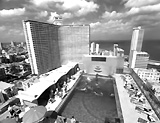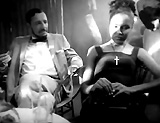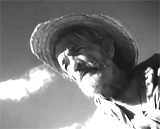
|
I Am Cuba (1964, Soviet Union/Cuba)
(aka Soy Cuba, or Я-Куба)
In Russian director Mikhail Kalatozov's long-forgotten
and rarely-seen cinematic work about the Cuban Revolution (and the
final days of the Batista regime) - composed of an episodic series
of four short stories or vignettes about the Cuban people on the
exotic Caribbean island, politically-supported by the Soviet Union;
the pro-Castro, propagandistic (agitprop) film was a joint
venture of Mosfilm, the Soviet film studio, and Cuba's ICAIC, the
new state film enterprise:
- the female-voiced narrator (Raquel Revuelta) who
broke into the storyline - known as "The Voice of Cuba" (in
the credits), with verses beginning: "I am Cuba"
- the bravura lengthy opening sequence with inventive
and fluid camera-work, featuring a hand-held camera filming with
a long continuous take - across Havana rooftops (including views
of affluent American tourists and bikini-clad beauties strolling
high up on an outdoor fashion runway platform as they were voted
upon by applause and photographed, and entertained by rock 'n' roll
musicians) - and then the camera descended to another roof-top and
its swimming pool where other US tourists were lounging, sunbathing,
being served drinks, playing cards, etc. - and without a cut, the
camera ducked underwater into the pool (after following one
of the bikinied brunettes into the water) - it was a decadent example
of an American-run gambling casino-hotel in the heart of Batista's
Havana - its skyline seen on the horizon
- the first episode: Cuban Maria/"Betty" (Luz
María Collazo) - a bar prostitute wearing a chic black dress,
was picked up by Jim (Jean Bouise) - an insensitive, wealthy American
tourist in a seedy and smoky nightclub; he was taken to her broken-down,
seaside, one-room shack for the night; the next morning, her fruit-seller
boyfriend Rene was dismayed when he realized his mistreated, innocent
fiancee was a hooker going by the name of Betty; as Jim fled, he
had to wind his way through the maze of alleyways and shacks: "I
am Cuba. Why are you running away? You came here to have fun. Go
ahead, have fun! Isn't this a happy picture! Don’t avert your
eyes. Look! I am Cuba. For you, I am the casino, the bar, hotels
and brothels. But the hands of these children and old people are
also me"
- the second episode: tenant-farmer peasant Pedro (José Gallardo)
learned that he had been evicted from his land, and that his sugar
cane crop had been sold by his greedy, co-opted landlord Senor Acosta
to the US United Fruit Company; frustrated and despairing, he set
fire to his field and shack, and perished from smoke inhalation: "I
am Cuba. Sometimes it seems to me that the trunks of my palm trees
are full of blood. Sometimes it seems to me that the murmuring sounds
around us are not the ocean, but choked-back tears. Who answers for
this blood? Who is responsible for these tears?"
- the third (main) episode: liberal, middle-class student
revolutionary Enrique (Raúl García) protested against
fascist police forces, and was tempted to use a sniper rifle to assassinate
the chief of police; he rallied with other friends and workers to
demonstrate against the oppressive regime; one radical student broke
away from officers during an arrest in an office, and began throwing
recently-printed leaflets off a balcony while shouting: "Long
Live Freedom!", he was shot in the back and killed, and his
body spiraled down to the plaza below; afterwards, as Enrique led
a major protest in the plaza to overthrow the system - on the grounds
of Havana University (the film scene paid homage to the Odessa Steps
sequence in Eisenstein's Battleship Potemkin (1925, USSR)),
the mob was met with powerful fire hoses; amidst the smoke of burning
cars, Enrique became the next martyr for the cause of Castro, when
the police chief shot him to death; his Cuban flag-draped body was
marched through Havana's streets in a massive cortege by his comrades;
in a dazzling one-take shot, the camera rose up from the street level,
crossed the street, entered the open window of a cigar-rolling factory
and then emerged on the other side of the room above the street and
rooftops (where a Cuban flag was unfurled from the window) as the
parade of grieving mourners passed below and stretched long into
the distance
- the fourth episode: peace-loving peasant Mariano
was barely surviving in a mountain hut in the area of the Sierra
Maestra; after his home and land was bombed by Batista's Air Force
and his young son was killed, he was drawn into joining rebel,
freedom-fighting guerrillas in the hills led by revolutionary Fidel
Castro: "I am Cuba. Your arms have gotten used to farming
tools, but now a rifle is in your hands. You are not shooting to
kill. You are firing at the past. You are firing to protect your
future"
|




Opening Sequence: Across Havana Rooftops


First Episode

Second Episode
|








